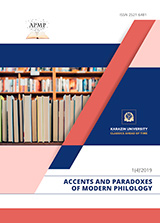The Minotaur’s Image in Pablo Picasso’s Works. An Iconological Study of the Subconscious
Abstract
The article analyzes the image of the Minotaur in the work of Pablo Picasso where the painter identifies himself with this mythological being. Such an identification dates back to the time of Picasso’s relationship with Marie-Thérèse Walter, at which point the painter takes up his old bullfighting theme, which will culminate in his epic Guernica. At that time Picasso also becomes interested in surrealism and Freud’s theories. In addition, the artist maintained a relationship of reciprocal admiration with the surrealist intellectuals and writers, who influenced him as well. Minotaur is a symbol of the instinctive force of the subconscious, and Picasso appropriates it to express the criminal and sexual impulse that ends up dominating the most entrenched conventions of the human being. All the characters of the Minotauromaquia represent Picasso himself in various dimensions of his mind. Minotaur is a human and an animal at the same time, a synthesis of the two main antagonists of the bullfight, which Picasso was so fond of; the human part of the Minotaur is also endowed with consciousness. The bullfight as a national holiday is a national tragedy as well, and in Picasso’s symbolic vision, the death is the only winner there. The influence of his relations with the beloved women in the imaginary of his painting is accentuated likewise, particularly in Picasso’s portraying of himself as a blind Minotaur which lets himself be carried away by a girl, and the presence of the bullfighter woman. The evolution of the bullfighting theme in the painter’s future facilitates the better understanding of the symbolism of his Guernica painting. For Picasso, ancient myths are not only an invented fable, but a source of inspiration for life impulses, which, as he feels, influence his personality.
Downloads
References
Alvar, Manuel, Picasso, los mitos y otras páginas sobre pintores, Edición conmemorativa del XXXII curso superior de filología española, Edición La Muralla, Madrid, 199, 134 p.
Bataille, George, Erotism: death & sensuality, City Lights Books, San Francisco, 1986, 280 p.
Bataille, Georges, Sur Nietzsche, volonté de chance, Paris-Gallimard, 1945, 253 p.
Becraft, Mel, Picasso’s Guernica: Images within Images, Vantagem, Nueva York, 1983, 70 p.
Blunt, Anthony, Picasso’s Guernica, Oxford University Press, New York, 1969, 60 p.
Brassaï, Conversations avec Picasso, Gallimard, Paris, 1964, 340 p.
Calvo Serraller, Francisco, El Guernica de Picasso, TF Editores, Madrid, 1999, 164 p.
Chipp, Herschel B. Picasso’s Guernica. History, Transformation, Meanings, California University Press, Berkeley, 1988.
Eliade, Mircea, Ordeal by Labyrinth. Conversations with Colaude Henri Rocquet, The University of Chicago Press, Chicago, 1978, 225 p.
Fisch, Eberhard, Guernica by Picasso, a Study of the Picture and its Contesxt, Associated University Presses, London; Cranbury, NJ, 1988, Print.
Glucksmann, André, Dostoievski en Manhattan, Taurus, Madrid, 2002, 260 p.
Herrera, Javier, Picasso, Madrid y el 98: la revista "Arte joven", Cátedra, Madrid, 1997, 303 p.
Janouch, Gustav, Conversaciones con Kafka. Notas y recuerdos, Destino, Barcelona, 1997, 349 p.
Johnson, Paul A., Al diablo con Picasso y otros ensayos, Grupo Zeta, Barcelona, 1998, 315 p.
K. Jung y otros, El hombre y sus símbolos, Aguilar, Madrid, 1969.
Inciarte, Fernando, Breve Teoría de la España moderna, Eunsa, Pamplona, 2002, 224 p.
Krauss, Rosalind E. La originalidad de la Vanguardia y otros mitos modernos, Alianza Forma, Madrid, 1996, 328 p.
Mailer, Norman, Portrait of Picasso as a young man: an interpretive biography, New York: Warner Books, 1996, 400 p.
Matisse, Henri, Escritos y opiniones sobre el arte (texto y notas establecidos por Dominique Fourcade), Debate, Madrid, 1993, 290 p.
Picasso, maestros y amigos españoles, Málaga, agosto-octubre, 2002 Catálogo
O’brian, P. Picasso, Noguer, Barcelona, 1977.
Picasso: Obra gráfica original 1904-1971, Ministerio de Cultura, Subdirección General de Artes Plásticas, Madrid, 1981, 512 p.
Picasso, toros y toreros, Catálogo, Réunion des musées nationaux: Diffusion Seuil, Paris, 1993, 255 p.
Picasso, Marina, Picasso, mi abuelo, Plaza y Janés, Barcelona, 2002, 208 p.
Ramirez, Juan Antonio, Picasso, el mirón y la duplicidad, Alianza Cien, Madrid, 1994, 72 p.
Rau, Bernd, Pablo Picasso. Obra gráfica, G. Gili, Barcelona, 1982, 191 p.
Richardson, John, Picasso: una biografía, Vol. II, Alianza, Madrid,1997, 502 p.
Rojas, Carlos, El mundo mítico y mágico de Picasso, Planeta, Barcelona, 1984, 222 p.
Russell, Frank D. El Guernica de Picasso. El laberinto de la narrativa y de la imaginación visual, Madrid, 1981, 322 p.
Schneider, Laurie, Arte y psicoanálisis, Cátedra, Madrid, 1996, 383 p.
Sebastian López, Santiago, El Guernica y otras obras de Picasso, Universidad de Murcia, Murcia, 1984, 128 p.
Sebastian López, Santiago, La clave del Guernica, Boletín del Museo e Instituto Camón Aznar, V, 1981, pp. 5–61.




